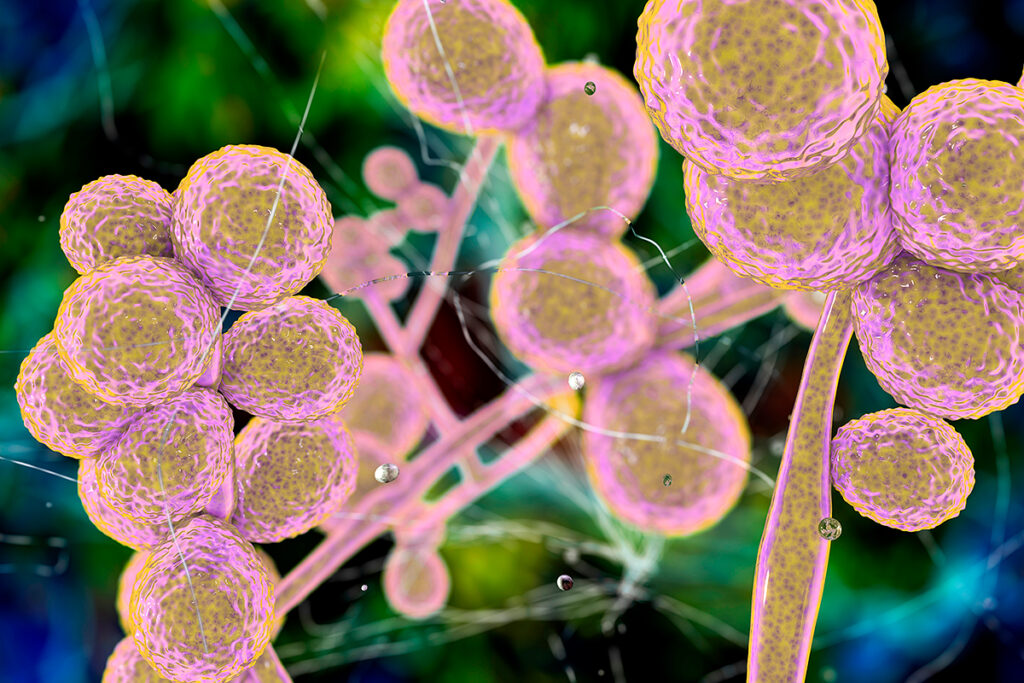Type I Interferons: Not Only Antiviral Action
Type I interferons (IFN-I) are crucial in protecting the body from viruses. However, a growing body of evidence suggests that IFN-I also plays an essential role during fungal infections.
All type I interferons activate the IFNAR receptor on the cell surface and trigger the expression of interferon-stimulated genes (ISGs). Proteins encoded by ISG have antiviral properties, but their function is not limited.
IFN-I can have both beneficial and harmful effects on the body. Interferons have antimicrobial and immunomodulatory properties and provoke solid inflammatory responses and tissue damage.
German scientists summarized data on the response of IFN-I during fungal infections caused by Candida species and Aspergillus fumigatus.
The Controversial Role of Type I Interferons in Invasive Fungal Infections
In fungal infections, the body triggers a type I interferon response. Nevertheless, the IFN-I response can play both a protective and detrimental role:
- Mice lacking the IFNAR receptor, which is important for triggering antiviral ISG expression, are more susceptible to candidiasis, indicating the protective role of IFN-I. The absence of IFNAR correlated with a reduced level of neutrophils.
- Another study has shown that a decrease in neutrophil levels due to IFNAR deficiency counteracts tissue damage and improves survival.
- A detrimental effect of IFN-I has been observed in Candida parapsilosis infection. Interferon triggered the production of IL-27, which worsened the clearance of the fungus – in mice with a deficiency of the IL-27R receptor, the Candida parapsilosis decreased faster. However, this did not affect survival in any way.
- IFNAR receptor-deficient mice suppressed Candida glabrata more rapidly 7 days post-infection. IFN-I promoted chronic fungal infection, although no such effect was seen in the later stages of the disease.
The detrimental effect of type I interferons in systemic fungal infections can be explained by interference with specific antifungal defense processes:
- IFN-β triggered the expression of ISG IFIT2, and IFIT2 suppressed the production of reactive oxygen species, which cells use to kill the fungus. In mice, IFN-β contributed to pathology and death from candidiasis.
- In Candida glabrata infection, IFN-I caused iron to accumulate in macrophages, the cells that engulf and digest the fungus. After macrophages took over Candida glabrata, the fungus gained access to iron, which promoted the reproduction of the fungus inside the cells and protected it from the immune response.
The effects of IFN-I may differ between mice and humans. Mutations in genes associated with IFN-I increase the likelihood of the fungus entering the bloodstream, which means that IFN-I-related genes are essential for human antifungal defenses.
- Mutations in the IFIH1 gene, which encodes the MDA5 receptor that triggers the IFN-I response, increased susceptibility to candidiasis.
- Compared to bacteria, Rhizopus oryzae and Aspergillus fumigatus, blood cells produced more IFN-I in response to Candida albicans.
- However, IFN-I promotes resistance to aspergillosis. The MDA5/MAVS receptor system triggers IFN-I and IFN-III responses that protect against aspergillosis. Moreover, IFIH1 mutations that predispose to candidiasis also predispose to aspergillosis.
- TLR3 is another nucleic acid receptor. TLR3 triggers the IFN-β response, which is involved in protection against aspergillosis. IFN-I, produced during lung infection by Aspergillus fumigatus, stimulates the antifungal activity of neutrophils through IFN-III signaling.
- Secretion of IFN-I also occurs when the Dectin-1 pattern recognition receptor detects the presence of β-glucan from the fungus Aspergillus fumigatus. A possible source of IFN-I in response to Aspergillus fumigatus is plasmacytoid dendritic cells (pDCs), which are crucial for antiviral defense. Therefore, both pDC and IFNAR are critical for aspergillosis resistance.
Type I Interferon on Mucosal Surfaces And Its Role in Fungal Commensalism
Commensalism is the coexistence of two different organisms, from which one benefits while the other receives neither benefit nor harm. An example of commensals is some intestinal microorganisms that do not usually harm the body.
Epithelial cells are responsible for forming innate immunity on the surfaces of the mucous membrane. They provide tolerance in commensal microbes or trigger the body’s defense reaction in case of infection.
Interferon and intestinal candidiasis. IFN-I regulates epithelial responses and can be both pro- and anti-inflammatory. Intestinal cells respond to IFN-I signaling, allowing the immune system to distinguish between commensal microorganisms and pathogens. Specific probiotic formulations increase local production of IFN-α, altering the intestinal microflora and inhibiting Candida’s growth. IFN-I can support the gut microbiota by acting directly on body cells to curb inflammation and shape the gut microbiota’s composition to suppress potential pathogens such as Candida spp.
Interferon and vulvovaginal candidiasis. In the early stage of infection with various Candida species, the vaginal mucosa responds to infection by IFN-I signaling and stimulation of ISG expression. At this stage, the epithelium is not yet damaged, and the interaction between the organism and the fungus resembles commensalism, not harming the fungus. At a later stage of infection, the level of IFN-I no longer rises. Thus, healthy women have higher levels of IFN-β in the vaginal fluid compared to women with vulvovaginal candidiasis. However, for IFN-α, the opposite effect is observed – the level of IFN-α is increased in patients with vulvovaginal candidiasis.
Chinese scientists have shown that IFN-I inhibits the growth of the fungus Candida albicans in vulvovaginal candidiasis, reduces inflammation and damage to the tissues of the vagina, restores the thickness of the epithelium, and enhances the immune response against candidiasis.
Fungi and Viruses: Cross-Protection or Increased Susceptibility?
Often viral infections are accompanied by fungal diseases. Aspergillus fungi can cause superinfections in critically ill patients with a viral illness:
- Influenza-associated pulmonary aspergillosis (IAPA);
- COVID-19-associated pulmonary aspergillosis (CAPA).
Both diseases significantly increase the level of IFN-I, and in severe cases of COVID-19, this exacerbates tissue damage.
On the other hand, severe COVID-19 is associated with developing autoantibodies against type I interferons. Since IFN-I is essential for protection against aspergillosis, severe COVID-19 predisposes to CAPA.
Influenza suppresses neutrophil recruitment to the lungs and increases susceptibility to aspergillosis. The absence of the STAT1 protein involved in the IFN response restored neutrophil recruitment and reduced the fungal load.
Sometimes a fungal infection helps protect against a viral one. So, Aspergillus Fumigatus activated immune cells – eosinophils which protect mice from influenza infection. A possible mechanism is the initial activation of the IFN-I antiviral system.
Immunotherapy of Fungal Infections with Type I Interferon
Immunotherapy for fungal infections can either boost a weakened immune system or suppress excessive inflammatory responses.
Treatment with IFN-I may be beneficial in mucosal candidiasis but not in systemic candidiasis. So, with vulvovaginal candidiasis, IFN-α increases the resistance of the epithelium to infection and reduces inflammation.
In the treatment of aspergillosis, IFN-I may also be helpful. Studies in mice showed that stimulation of the interferon response and the administration of IFN-I improved antifungal immunity and disease outcome.
IFN-I is vital in maintaining the intestinal barrier and may reduce the penetration of Candida albicans through the intestinal barrier.
IFN-I is involved in the interaction of epithelial cells with the immune system during commensalism and fungal infection. Treatments that affect the interferon system can help with fungal infections of the intestines, lungs, and vaginal mucosa.
Useful article, necessary information? Share it!
Someone will also find it useful and necessary:



